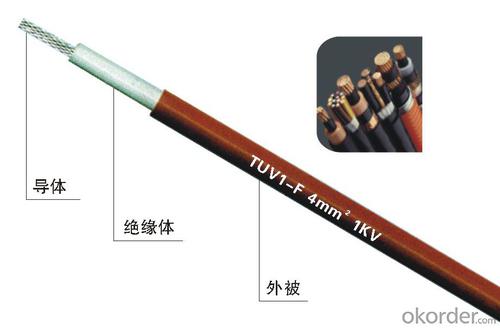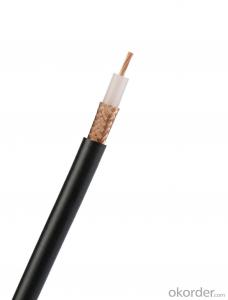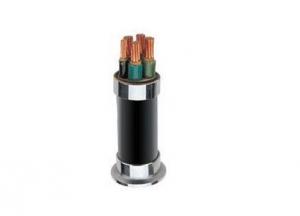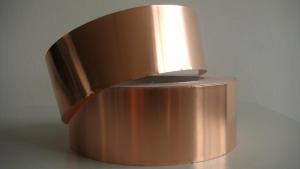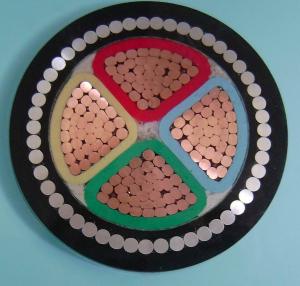0.6/1kv low smoke zero halogen flame retardant photovoltaic cable
- Loading Port:
- Tianjin
- Payment Terms:
- TT OR LC
- Min Order Qty:
- 100 m
- Supply Capability:
- 100000 m/month
OKorder Service Pledge
OKorder Financial Service
You Might Also Like
0.6/1kv low smoke zero halogen flame retardant photovoltaic cable
Photovoltaic Cable
Introduction of product
Our company produces Photovoltaic Cable which is used in advanced radiation cross-linking technology and used low smoke zero halogen flame retardant material produced wires. It has advantages of high temperature resistant, anti oxygen pumping, uv resistance, resistance to water vapor, antimicrobial, short cutting ability, long service life, wear-resisting, oil, anti-corrosion, high tensile resistance, etc.
Executive standard
The product is according to the standard of TüV 2PfG 1169/08.07.
Application
The product is suitable for use in extreme weather conditions, indoors and outdoors solar photovoltaic system circuit connection.
Operating characteristics
U0/U
U0/U 0.6/1kV
Operating temperature
Max. operating temperature of conductor: 120℃, Operating ambient temperature: -40℃~90℃.
Type name
Type | Name |
PV1—F | Low smoke zero halogen radiation XLPO insulation low smoke zero halogen radiation XLPO sheath pv cable |
Specification of cable
Type | Nom. Cross-Section /mm2 | NO.of cores |
PV1-F | 1.5 | 1 |
PV1-F | 2.5 | 1 |
PV1-F | 4 | 1 |
PV1-F | 6 | 1 |
PV1-F | 10 | 1 |
PV1-F | 16 | 1 |
PV1-F | 25 | 1 |
PV1-F | 35 | 1 |
1.sheath
2.Conductor
3.Insulation
Structure data of cable
Nom. Cross-Section of conductor/mm2 | Conductor structure/piece/mm | Conductor diameter/mm | Product diameter/mm | Max direct resistance (20℃Ω/km) | Referencen weight kg/km |
1.5 | 30/0.25 | 1.58 | 5.08 | 13.7 | 33.4 |
2.5 | 50/0.25 | 2.04 | 5.54 | 8.21 | 46.2 |
4 | 56/0.30 | 2.59 | 6.19 | 5.09 | 65.8 |
6 | 84/0.30 | 3.4 | 7.00 | 3.39 | 92.4 |
10 | 84/0.40 | 4.5 | 8.90 | 1.95 | 157.4 |
16 | 126/0.40 | 5.55 | 10.35 | 1.24 | 225.8 |
25 | 196/0.40 | 6.92 | 11.92 | 0.795 | 329.4 |
35 | 276/0.40 | 8.7 | 13.9 | 0.565 | 445.1 |


- Q: A pair of Copper wire mains, each of 3.87 sq.cm cross section use to transmit the power, a distance of 915m for 10 hours a day, 80 kilo watt at 200 volts are taken from the mains, find power lost in cable per day at resistivity 1.7 micro ohm.cm.Note: Question is talking about A PAIR OF COPPER WIRE
- Power loss per day is meaningless, I assume you mean energy loss per day, or power loss You have to calculate the resistance in the wire. Resistance of a wire in Ω R = ρL/A ρ is resistivity of the material in Ω-m L is length in meters A is cross-sectional area in m? A = πr?, r is radius of wire in m resistivity Cu 17.2e-9 Ω-m 3.87 cm? = 3.87 e-6 m? R = (2*915)(17.2e-9) / (3.87 e-6) = 8.13 ohms 80 kW at 200 volts is a current of 80000/200 = 400 amps You cannot put 400 amps through an 8 ohm resistance, as that requires a voltage of 3200 volts, which we don't have. So the premise of 80 kW is not possible. Perhaps you copied one of the numbers incorrectly. .
- Q: Cable yjv-0.6 / 1kv-4 * 120 + 1 * 70 What does it mean?
- "Electrical design of civil buildings," 8.10.13; steel cable bridge straight section length of more than 30m, aluminum or glass fiber reinforced plastic cable bridge length of more than 15m, should be set up expansion joints. Cable bridge across the building deformation joints, should be set compensation device. The telescopic section is set for temperature change; the compensating device is to prevent settlement at the deformation.
- Q: I do not have the Video Card in hand but I will in a few days and I already know the adapter cable has gone missing. The NVdia Website is no help. I have an HP Pavilion Elite desktop. I want to acquire the cable before I receive the Video Card, so I can install it right away. I want to know exactly the type of power connector cable is so I can go online and order it now.
- Power connector cable? Usually, you don't need an adapter cable: you just plug the video card into one of the PCI expansion card slots available on the motherboard, then you plug the monitor's cable to connect the monitor to the computer via the serial port on the video card. Knowing what computer you have doesn't really help: You have to tell us the motherboard's brand model to see if this particular video card is compatible for your computer's motherboard.
- Q: Hi,I have a second-hand Antec NeoHE 550 power supply and I'd like to find a cable for it. I can't seem to find it on the Internet though.The cable is pictured here (the second from the left)On one end it has a 6-pin PSU connector and on the other end, it's a *female* 4-pin Molex connector. It is not a PCI-E cable.I'd like to know where I can buy one, I don't even know what to look for on Google.Thanks a lot!
- I okorder /... That is an exact replacement part for the Neo Power supplies. On a side note, not too many people are aware that Antec doesn't actually make power supplies. Antec sells a lot of power supplies, but they are all made by other companies. If I knew who made your specific Neo model, I might be able to find an exact replacement part sourced from whoever made that power supply, also.
- Q: I live in Chicago, and I want to know if somebody can help me. The next house on mine have electrical power cable, telefon and cable from my back yard and pas my propriety aprox 60 tf, the last two stay on my garage, its legal ?Know haw i can do to move the cable? some codes or regulation, samething? Thanks, Best regards.
- If you suspect someone is in violation of the electrical code for the city of chicago call the City offices and ask for the electrical inspector ..ask them to take a look..Better safe than sorry...From the E..
- Q: Do you know what type of power cable fits this ?
- Not sure what the item is, but by the relative size the connector is designed for a power supply unit to plug into it at a reduced voltage. Give us a clue about the device and I am sure more help will be forth coming UPDATE Okay see it now. Its a 13V 4 amp AC adaptor. None availble from dell or altec. You can them on OKorder Heres a unit in the UK cgi.OKorder .uk/NEW-Altec-Lansing-13V-AC-Adaptor-A4545-for-ACS340-2420R_W0QQitemZ310050699532QQcmdZViewItemQQptZUK_Computing_DesktopComponents_RL?hash=item310050699532_trksid=p3286.c0.m14_trkparms=72%3A1301%7C66%3A2%7C65%3A12%7C39%3A1%7C240%3A1318
- Q: I have a white Xbox 360 system (elite maybe). I have it hooked up to a 26HD TV in my room. When I have friends over to play, we like to move the xbox downstairs to a 52TV so we can play split screen mode without squinting! The unplugging of cables creates such a hassle, and I was wondering if it was possible to use another AC power cable and more video cables downstairs so I only have to move the console itself. Can someone tell me if this will work if I purchase another set of cables on OKorder and or give any specifications about what need/should buy?Please help, and thanks!
- you certainly can do that. the only problem is that the power brick is like 100 bucks but if you think it's worth it then you certainly have that option. if your tv is an hd tv, then buy an hdmi cable. i got one from the apple store for 20 bucks and it works great. just the power is so expensive.. OKorder is different. if you went to the store and bought a new one, or if you ordered one directly from microsoft, it would be 100 dollars. i'm sure people sell used ones on OKorder or craigslist for much less but it's your call if you want to risk them ripping you off or something. hdmi is the high definition equivalent of component or av cables. it feeds the video and audio to the tv. it doesn't provide power. if you do get hdmi, don't forget to go to your xbox video settings and change the output from standard 1080p
- Q: I have a simple 400watt amp going to a single 10inch kicker sub, nothing crazy. I need to know what gauge of power cable would be safe. An 8 gauge for example...
- 8 awg would be fine for 400w rms
- Q: How do I connect this unit to my cd player? Splicing power cables? not too detailed in the manual.?
- im sure it comes with a power harness(plug) you prob have to do some splicing just connect it t0 the same place where you get power for the cd player your probably going to get a wire harness for your cd player right? just match the wires from your cd to your ipod thingy before you solder or crimp your connections
- Q: YJV2226 / 35KV3 * 185 cable unit resistance, reactance is how much? This knowledge in which the book to find?
- Buried a few is based on the project to be set, as to how much diameter will be based on your plan to determine the cable, the national standard to protect the tube diameter at least 1.5 times the diameter of the cable through the cable. Embedded is to consider the size of long-term power supply, when the load increases, you can directly in the embedded casing to wear cables, so that one-time embedded well, not to re-dig cable cable buried cable, saving time and effort, but also to avoid the Damage to the original cable foundation and the road above the cable
Send your message to us
0.6/1kv low smoke zero halogen flame retardant photovoltaic cable
- Loading Port:
- Tianjin
- Payment Terms:
- TT OR LC
- Min Order Qty:
- 100 m
- Supply Capability:
- 100000 m/month
OKorder Service Pledge
OKorder Financial Service
Similar products
Hot products
Hot Searches
Related keywords


